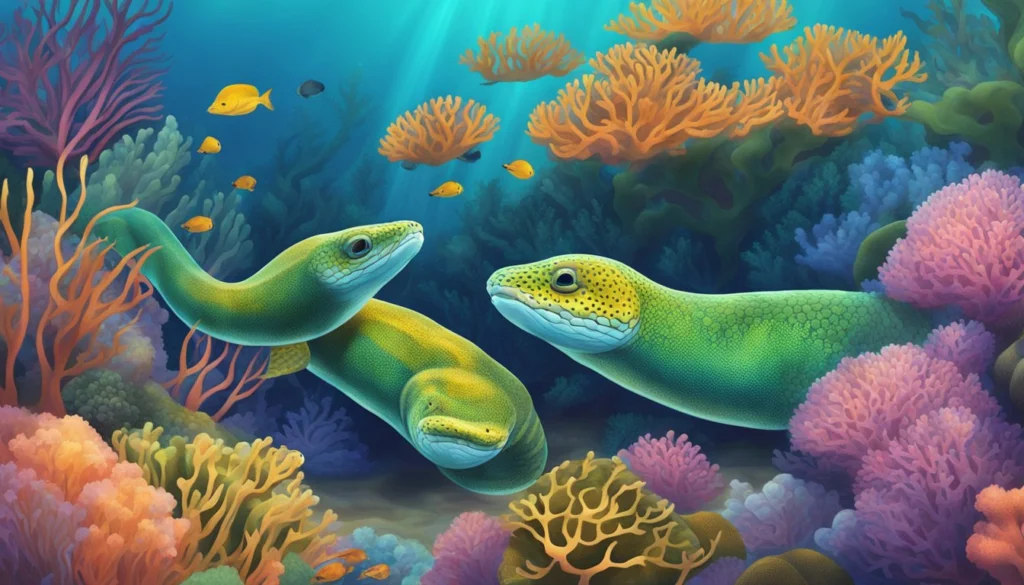Moray eels are some of the most intriguing creatures of the ocean. Known for their long, snake-like bodies and fierce, toothy appearance, these eels are often spotted lurking in coral reefs and rocky crevices. Despite their menacing look, moray eels play a critical role in marine ecosystems and have many unique features that set them apart from other fish. Let’s dive into six fascinating facts about these enigmatic underwater predators.
1. Over 200 Species Worldwide
Moray eels are incredibly diverse, with over 200 species found in oceans across the globe. They thrive in tropical and subtropical waters, making coral reefs and rocky underwater structures their ideal habitats. Some species, such as the Giant Moray (the largest of all morays), can grow over 10 feet long, while others, like the Ribbon Eel, are smaller and more colorful.
Each species of moray eel is uniquely adapted to its environment. While most live in saltwater, a few species can tolerate brackish waters. Their ability to blend in with their surroundings, along with their secretive nature, makes morays masters of disguise.
Key Species:
- Giant Moray: Can grow up to 10 feet long
- Ribbon Eel: Known for its striking, colorful appearance
- Snowflake Moray: A common species found in home aquariums
2. They Have Two Sets of Jaws
One of the most unique and terrifying features of the moray eel is its pharyngeal jaws. In addition to their primary jaws, which are lined with sharp teeth, morays have a second set of jaws located in their throat. These pharyngeal jaws shoot forward to grab prey after it has been captured by the primary jaws, pulling it further into the eel’s digestive system.
This mechanism is similar to the “alien” creature depicted in science fiction movies, and it allows moray eels to hold onto slippery prey like fish, octopuses, and crustaceans with incredible efficiency. This dual-jaw system sets moray eels apart from most other fish and makes them formidable hunters.
How the Dual-Jaw System Works:
- Primary Jaws: Capture prey with sharp teeth
- Pharyngeal Jaws: Extend from the throat to drag prey deeper into the mouth
3. Skin Instead of Scales
Unlike many fish, moray eels do not have scales. Instead, they have smooth, scaleless skin covered in a layer of mucus. This mucus provides protection from abrasions as they squeeze through tight spaces in coral reefs and rocky crevices. The mucus coating also helps guard against parasites and infections, giving moray eels an extra layer of defense in the wild.
The skin of some species of moray eels also contains toxins, which help deter predators. Their slippery, flexible bodies allow them to navigate effortlessly through narrow spaces, making them adept ambush predators and excellent at avoiding danger.
Why It’s Important:
- No Scales: Mucus-covered skin instead of traditional fish scales
- Toxins: Some species produce toxic mucus to ward off predators
- Flexibility: Their skin and body structure allow them to navigate tight spaces
4. Ambush Predators
Moray eels are expert ambush predators. Instead of actively chasing prey, they rely on stealth and patience, hiding in crevices and coral reefs while waiting for an unsuspecting fish or crustacean to pass by. When prey comes close enough, the moray eel strikes with lightning speed, using its sharp teeth and dual jaws to grab and swallow its meal.
Their elongated, snake-like bodies make it easy for them to stay hidden while only their heads poke out of their hiding spots. Their sharp teeth are designed to latch onto and hold slippery prey, making escape nearly impossible once an animal has been caught in the moray’s jaws.
Hunting Strategy:
- Ambush Predator: Hides and waits for prey to come close
- Rapid Strike: Attacks with speed and precision
- Sharp Teeth: Designed to hold onto slippery prey like fish and octopuses
5. They Have Poor Vision but Excellent Smell
Moray eels do not rely heavily on sight to find prey. Instead, they use their highly developed sense of smell to detect food. This sense is so acute that moray eels can locate prey hiding in crevices or under the sand. Their poor eyesight is compensated by their olfactory prowess, making them effective hunters even in the darkest corners of the ocean.
In fact, moray eels are known to be most active during the night, when they use their sense of smell to navigate and hunt in the dark. Their nocturnal hunting behavior allows them to take advantage of prey that is less active or hiding during the day.
Senses:
- Poor Vision: Relies more on smell than sight
- Powerful Sense of Smell: Can detect prey even when hidden
- Nocturnal: More active and better at hunting during the night
6. Symbiotic Relationships with Cleaner Fish
Despite their fearsome reputation, moray eels are known to engage in symbiotic relationships with cleaner fish. Small species like wrasses and shrimp will swim into the open mouths of moray eels to feed on parasites, dead skin, and food particles. These cleaner fish provide a valuable service by keeping the eel healthy, while the eel offers them protection from larger predators.
This interaction is fascinating because the moray eel could easily eat the cleaner fish, yet it allows them to perform their cleaning duties without harm. This mutualistic relationship showcases the complex interactions that occur in coral reef ecosystems, where species rely on one another to survive.
Symbiosis:
- Cleaner Fish: Small fish and shrimp clean the eel’s teeth and skin
- Mutual Benefit: Eels stay clean, while cleaner fish receive protection and food
- Complex Ecosystem Interaction: A demonstration of the balance in coral reefs
Conclusion
Moray eels are captivating creatures with unique adaptations that make them formidable predators in their marine environments. From their dual jaws and specialized hunting techniques to their symbiotic relationships with other species, moray eels demonstrate the complexity and beauty of ocean life. While their appearance may be intimidating, these animals are an essential part of the underwater ecosystem, playing vital roles in maintaining the balance of coral reef habitats.
FAQ
Are moray eels dangerous to humans?
While moray eels are not typically aggressive towards humans, they can bite if provoked or startled. Their sharp teeth can cause injury, so it’s best to observe them from a distance in the wild.
What do moray eels eat?
Moray eels primarily feed on fish, crustaceans, and octopuses. They use their sharp teeth and dual jaws to catch and consume prey.
How long do moray eels live?
Moray eels can live up to 30 years in the wild, though their lifespan varies depending on the species and environmental conditions.
Do moray eels have good eyesight?
Moray eels have relatively poor vision and rely more on their sense of smell to locate prey.
Where are moray eels found?
Moray eels are found in tropical and subtropical oceans worldwide. They typically inhabit coral reefs, rocky crevices, and underwater caves.
Can moray eels be kept in home aquariums?
Yes, certain species of moray eels, such as the Snowflake Moray, can be kept in home aquariums, but they require large tanks and special care to maintain their health.


